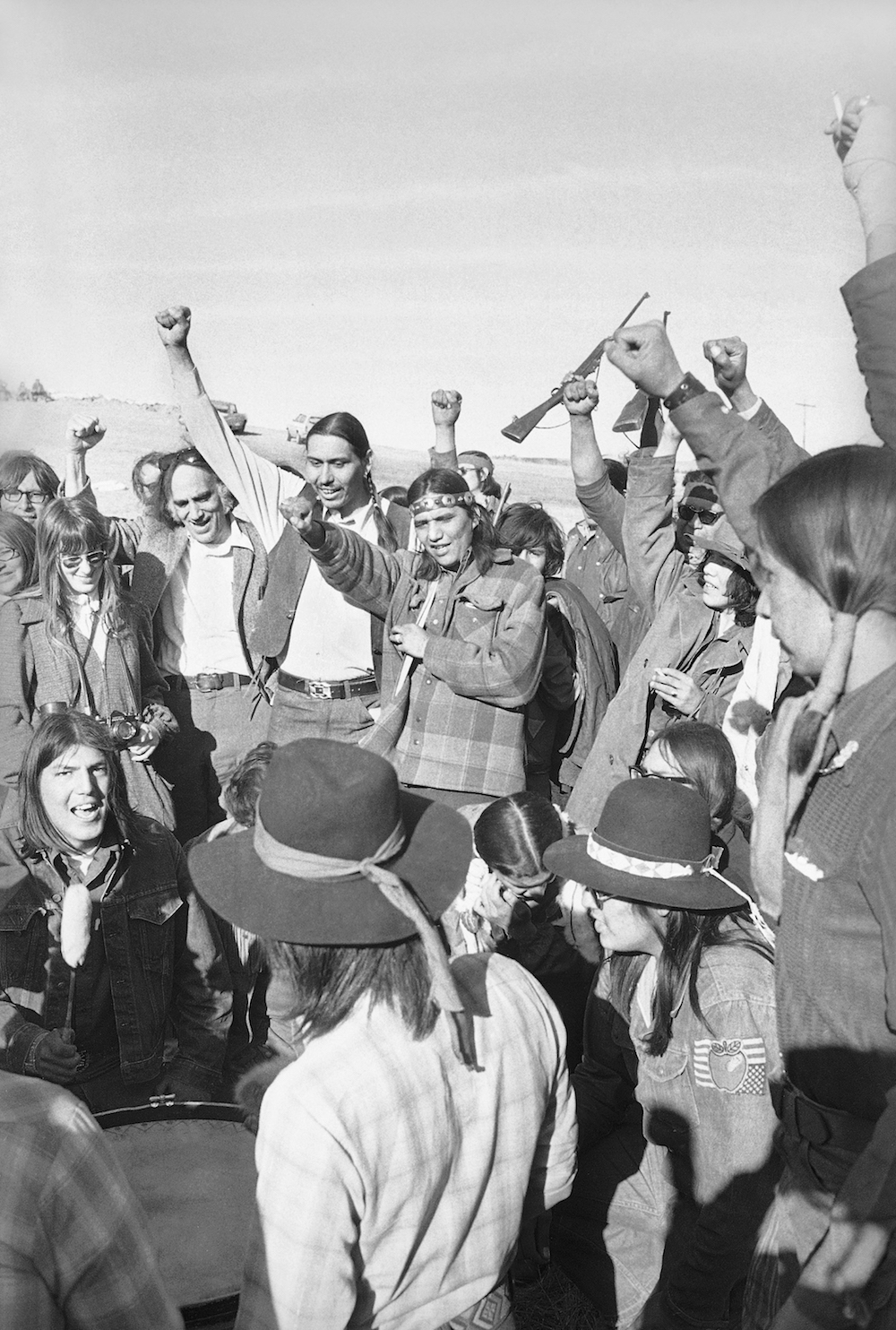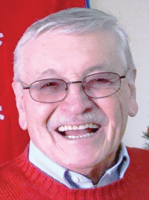
American Indian Movement (AIM) members and supporters celebrate the pullout of federal lawmen from roadblocks in Wounded Knee, South Dakota, on March 10, 1973. Federal forces surrounded Wounded Knee for over a week following AIM's takeover of the town
The television cameras were all packed away and stuffed into the trunks of the rental cars. Notebooks were crammed into briefcases and alongside the cameras, packed in rental cars headed for Rapid City.
New York Times journalist Bill Kovach, covering the Wounded Knee takeover—when, in 1973, approximately 200 supporters of the American Indian Movement (AIM) seized the town of Wounded Knee and occupied it for 71 days, during which time two Sioux men were shot and killed by federal agents and several others were wounded—made the in-house newsletter of the Times when his Hertz rental car, parked at Wounded Knee, was stripped of everything strippable and left on blocks on the outskirts of the village. The Times in-house story about the perils Kovach encountered was titled, “Bury My Hertz at Wounded Knee.”
All of the journalists based in places far from Wounded Knee wrongfully assumed that since the occupiers had abandoned Wounded Knee the story was over. They weren’t there to watch the occupiers file out of Wounded Knee in a line of cars only to be stopped and searched by the U. S. marshals. The marshals confiscated all of the loot and stolen works of art that the occupiers had squirreled away in their cars hoping to make a quick profit on them.
They recovered priceless works of art by such great Lakota artists as Andrew Standing Soldier, Felix Walks Under the Ground, Richard Red Owl, and Hobart Keith. All in all they confiscated 42 works of art from the occupiers.
The war between the American Indian Movement (AIM) and the government of the Oglala Sioux Tribe raged on. Several deaths occurred between the bitter rivals. Lakota people who lived in or near Wounded Knee lost all of their possessions, including their homes and cars, and filed with the U.S. government for restitution. Their claims were put into the circular file in most cases and very few Lakota people were ever paid for their losses. Their homes were destroyed by the occupiers and their cars were stolen.
The children of James Czywczynski, the owners of the Wounded Knee Trading Post, which was also destroyed, found that the horses they loved had also disappeared. In fact everything they owned had either been stolen or destroyed.
The battles between AIM and the tribal government were still raging when in 1981 I started my weekly newspaper, the Lakota Times, right in the heart of Pine Ridge Village. A strong believer in freedom of the press, I used my editorial page to point out the damage the warring sides were doing to the everyday citizens of the reservation. I wrote editorials condemning both sides for the violence. My first issue of the Lakota Times hit the reservation on July 1. Five months later, in December of 1981, the windows of my newspaper were shot out. We had no idea of who was behind it.
The first of the year in 1982 we moved our paper across the street to a more secure building after our windows had been shot out a second time. The windows at our new office were covered with bars and yet someone fired a rifle through the bars in November of that year and shot out the glass.
We continued to write strong editorials calling those who would strike out at our newspaper in the middle of the night “cowards.” In December, just a few days before Christmas, a car pulled up in front of our office and two men jumped out and hurled Molotov cocktails at our newspaper in an effort to burn it down. Fortunately, a police officer from the Oglala Sioux Tribe happened on the scene and kicked the burning bottles of gasoline away from the building. Our newspaper office was scorched, but we kept on publishing. A few nights later, after I put the paper to bed about midnight, I got into my pickup truck and was just about to start the motor when a bullet crashed through my windshield missing my head by a couple of inches.
I learned later from a fellow journalist who also was a member of AIM that they were angry at the editorials I was writing, particularly the editorials condemning their leaders, Russell Means and Dennis Banks. I asked her why they would do something like that and why, as a news journalist, she didn’t speak out. She said everyone was too frightened to speak up. AIM had labeled tribal chairman Dick Wilson and his administration as the “goons.”
The next day after the firebombing of my newspaper the chairman of the Oglala Sioux Tribe, Joe American Horse, called a special emergency meeting of the Tribal Council. At that meeting he not only admonished those attacking my newspaper, but proclaimed that from this day forward, any attack on the newspaper would be considered an attack on the tribe itself. The attacks stopped.
During all of this trauma the South Dakota Newspaper Association and its members were ominously silent. Finally, Jim Carrier, the managing editor of the Rapid City Journal, wrote a story about the attacks on a fellow newspaper summing it up with, “This is happening in America.”
About the same time a courageous lady named Phyllis Justice, editor of the Grant County Review in Milbank, South Dakota, wrote a powerful editorial condemning those who would try to abolish freedom of the press in South Dakota through violent means. It made my day to have at least two South Dakota journalists stand up for us.
And finally Nellie Red Owl, a powerful member of AIM who knew my father when he was a clerk at the Coast to Coast Hardware Store in Batesland, South Dakota, her hometown, spoke out to her fellow AIM members about protecting our right to freedom of the press. I think it was her voice that made the difference.
A few days later, Milo Yellow Hair, a supporter of AIM, came into my office, shook hands and said he would be there for us if we needed him. And so freedom of the press was reborn on the Pine Ridge Reservation in 1982.
Through it all I believe our voice as a small weekly newspaper made a major difference on the reservation in helping to bring most of the violence to an end.
As our newspaper grew and spread across all nine Indian reservations in South Dakota I saw so-called authors come to the reservation and try to write about something they knew nothing about and their books for the most part told only one side of the story, that of AIM. Not one of those writers ever stopped into my office and asked to hear the other side of the story.
I often wished that some of those reporters who came to the Pine Ridge Reservation in 1973 would have hung around long enough to cover the battles that still raged. I wish they had stuck around long enough to write about how the Oglala Sioux Tribe managed to pull itself up by its bootstraps despite the odds they faced.
These journalists would have seen the birth of a college system on the reservation that eventually had a campus in each of the nine districts. Today Oglala Lakota College even has a campus, its largest, in Rapid City. They would have been able to write about a young Lakota woman named SuAnne Big Crow who led the Lady Thorpes of Pine Ridge High School to the State A Basketball Championship.
But the only writers who came around were those who wanted to make a few bucks by writing their slanted stories on the backs of the Lakota people. One writer came into my office and said he was there to write some stories about the Pine Ridge Reservation. “You’ll have to pardon my ignorance but …”
I cut him off immediately with, “No, I will not pardon your ignorance. How dare you come to this reservation and declare your ignorance before you ever write a story.”
And I tell all writers then and now, if you come out to Indian Country to write about us, do your damned homework.


